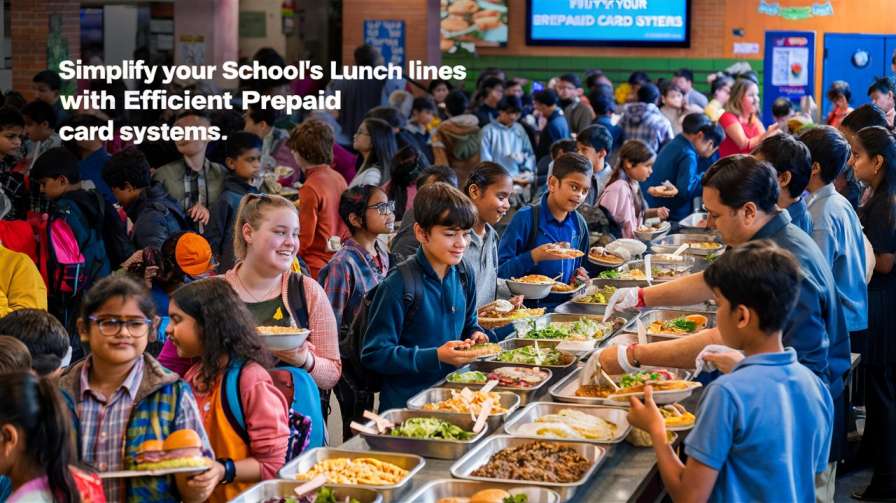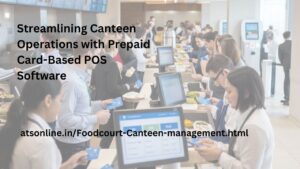Discover how prepaid card systems can simplify school lunch lines, reduce wait times, enhance financial management, and improve student well-being. Learn the benefits and steps to implementation.
Efficient lunch management is crucial in schools to ensure students receive their meals promptly and without unnecessary stress. Traditional payment methods, such as cash transactions, often lead to long lines, errors in transactions, and increased pressure on cafeteria staff. Prepaid card systems offer a modern solution, revolutionizing the way school lunches are managed and providing numerous benefits to all stakeholders involved.
The Current Challenges in School Lunch Lines
Managing school lunch lines is a multifaceted challenge. Here are some of the common issues faced:
- Long Waiting Times: Cash transactions and manual entry systems slow down the process, leading to long lines and reduced time for students to eat.
- Transaction Errors: Handling cash increases the likelihood of errors, causing delays and discrepancies.
- Inefficient Resource Use: Cafeteria staff spend a significant amount of time managing payments instead of focusing on meal preparation and service.
- Financial Management Issues: Keeping track of cash and ensuring accurate accounting can be challenging for school administration.
- Nutritional Concerns: Students might skip meals or opt for less nutritious options due to long waits or lack of funds.
What is a Prepaid Card System?
A prepaid card system is a cashless payment method where students use a card loaded with funds to pay for their meals. These cards can be topped up online, through mobile apps, or at designated locations within the school. The system integrates with the school’s cafeteria management software, allowing for seamless transactions.
How Prepaid Card Systems Work in Schools
Here’s a step-by-step overview of how prepaid card systems can be implemented in a school setting:
- Card Issuance: Students receive a prepaid card linked to their personal account.
- Loading Funds: Parents or guardians can add funds to the card online, through a mobile app, or via designated kiosks in the school.
- Making a Purchase: At the cafeteria, students simply swipe their card to pay for their meals. The transaction is quick and the amount is deducted from their balance.
- Account Management: Parents can monitor spending, view transaction history, and set spending limits through an online portal.
- Reporting and Analytics: School administrators have access to detailed reports on meal purchases, helping with inventory management and financial planning.
Benefits of Prepaid Card Systems
Efficiency and Time Savings
One of the most significant advantages of prepaid card systems is the reduction in transaction time. A swipe of a card is much faster than handling cash, making the lunch line move more quickly. This efficiency reduces wait times, allowing students more time to enjoy their meals and socialize.
Enhanced Financial Management
Prepaid card systems simplify financial management for both parents and school administrators. Parents can easily add funds and monitor their child’s spending, ensuring money is used for its intended purpose. For schools, the system offers streamlined accounting and reduces the risks associated with handling cash.
Improved Nutrition and Student Well-being
With faster transactions, students have more time to choose healthier meal options rather than rushing through the line. Additionally, parents can set spending limits and monitor meal choices, promoting better nutrition and overall student well-being. The reduction in stress and chaos during lunch periods also contributes to a more positive school environment.
Implementing a Prepaid Card System
Steps to Implementation
- Assessment and Planning: Conduct a needs assessment to understand the current challenges and identify goals for the prepaid card system.
- Vendor Selection: Choose a reliable vendor that provides robust prepaid card solutions tailored to school environments.
- System Integration: Ensure the prepaid card system integrates seamlessly with existing cafeteria management software.
- Pilot Program: Start with a pilot program to test the system, gather feedback, and make necessary adjustments.
- Full Implementation: Roll out the system school-wide, ensuring all stakeholders are informed and trained.
Training and Support
Training is essential for a smooth transition. Provide comprehensive training sessions for cafeteria staff, parents, and students. Continuous support should be available to address any issues that arise and to assist users in adapting to the new system.
Addressing Common Concerns
- Privacy and Security: Ensure the system complies with data protection regulations to safeguard student information.
- Accessibility: Make sure the system is user-friendly and accessible to all students, including those with disabilities.
- Technical Issues: Have a robust support system in place to handle technical problems swiftly.
Case Studies and Success Stories
Many schools have successfully implemented prepaid card systems, witnessing remarkable improvements in their lunch management processes. For instance:
- A High School: After implementing a prepaid card system, A High School reported a 50% reduction in wait times and a 30% increase in student participation in the lunch program.
- Middle School: Middle School saw a significant decrease in cash handling errors and improved financial management, with parents appreciating the ease of adding funds online.
These success stories highlight the transformative potential of prepaid card systems in enhancing the efficiency and effectiveness of school lunch programs.
Future of School Lunch Systems
As technology continues to evolve, the future of school lunch systems looks promising. Innovations such as mobile payment solutions, biometric identification, and AI-powered meal recommendations could further streamline the process and enhance the student experience. Schools that embrace these technologies will be better positioned to provide efficient, nutritious, and enjoyable lunch experiences for their students.
Conclusion
Implementing a prepaid card system in school cafeterias is a smart, forward-thinking solution to the common challenges faced in managing lunch lines. By reducing wait times, minimizing transaction errors, and improving financial management, these systems create a more efficient and pleasant lunchtime experience for students and staff alike. The benefits extend beyond mere convenience, positively impacting student nutrition, well-being, and overall school culture. As schools continue to seek innovative ways to improve their operations, prepaid card systems stand out as a viable and beneficial option.
We hope you enjoyed reading our blog posts about prepaid card school billing solutions. If you want to learn more about how we can help you manage your business, please visit our website here. We are always happy to hear from you and answer any questions you may have. You can reach us by phone at +91 9810078010 or by email at ats.fnb@gmail.com. Thank you for your interest in our services.
https://atsonline.in/Cashless-School-Card.html
FAQs
1. How do prepaid card systems work in school cafeterias?
Answer: Prepaid card systems allow students to use a card loaded with funds to pay for their meals. Parents or guardians can add funds online, via a mobile app, or at designated school kiosks. Students swipe their card at the cafeteria checkout, and the transaction is automatically deducted from their balance.
2. What are the benefits of using a prepaid card system for school lunches?
Answer: Prepaid card systems reduce wait times, minimize transaction errors, and improve financial management for both parents and school administrators. They also promote better nutrition by giving students more time to choose healthy meals and allowing parents to monitor spending and set limits.
3. How secure is a prepaid card system for students?
Answer: Prepaid card systems are designed with robust security measures to protect student information and transactions. They comply with data protection regulations and often include features like PIN protection and real-time transaction monitoring to ensure security.
4. What steps are involved in implementing a prepaid card system in schools?
Answer: Implementation involves assessing current challenges, selecting a reliable vendor, integrating the system with existing cafeteria software, running a pilot program, and then rolling out the system school-wide. Training for staff, students, and parents is also essential for a smooth transition.
5. How can parents add funds to their child’s prepaid card?
Answer: Parents can add funds to their child’s prepaid card through various methods, including online portals, mobile apps, or designated kiosks within the school. They can also monitor spending, set spending limits, and view transaction history through these platforms.
We hope you enjoyed reading our blog posts about prepaid card school billing solutions. If you want to learn more about how we can help you manage your business, please visit our website here. We are always happy to hear from you and answer any questions you may have. You can reach us by phone at +91 9810078010 or by email at ats.fnb@gmail.com. Thank you for your interest in our services.
https://atsonline.in/Cashless-School-Card.html




